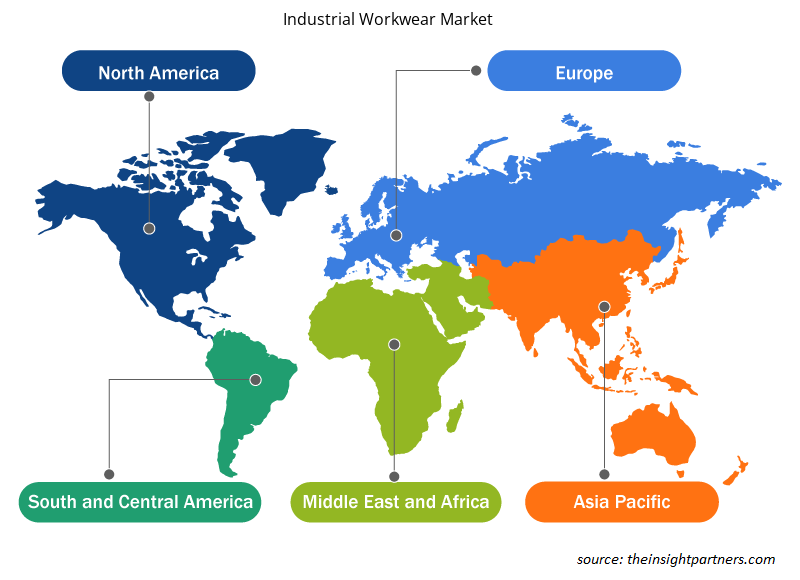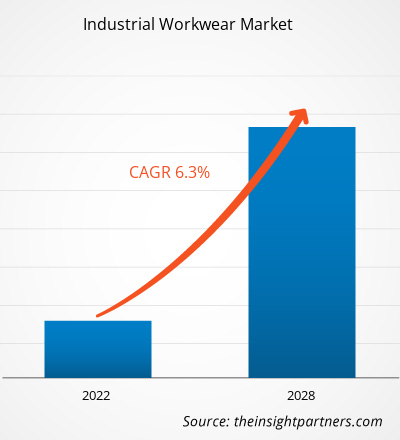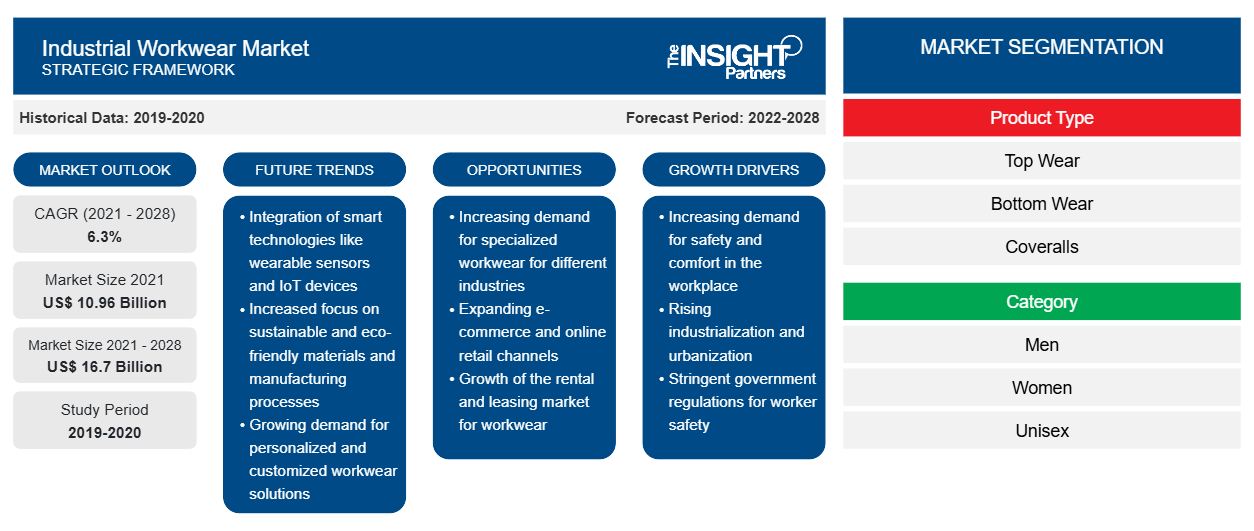Si prevede che il mercato degli indumenti da lavoro industriali raggiungerà i 16.697,49 milioni di dollari entro il 2028, rispetto ai 10.956,69 milioni di dollari del 2021. Si prevede che crescerà a un CAGR del 6,3% dal 2022 al 2028.
Gli indumenti da lavoro industriali garantiscono sicurezza ai lavoratori e un ambiente di lavoro sano. Gli indumenti da lavoro sono ampiamente utilizzati in vari settori, tra cui petrolio e gas, prodotti chimici, edilizia, produzione, automotive, agricoltura e estrazione mineraria. Negli ultimi anni, le preoccupazioni dei lavoratori in materia di sicurezza nei settori industriali sono aumentate rapidamente. Vari governi e associazioni per la sicurezza stanno imponendo linee guida industriali per garantire la sicurezza dei lavoratori, il che ha fatto aumentare la domanda di indumenti da lavoro.
Nel 2020, il Nord America ha detenuto la quota maggiore del mercato globale degli indumenti da lavoro industriali e si stima che l'Asia Pacifica registrerà il CAGR più elevato durante il periodo di previsione. I paesi emergenti dell'Asia-Pacifico, tra cui Cina e India, stanno assistendo a un'impennata delle misure e delle spese per la sicurezza sul lavoro, il che offre ampie opportunità per i principali attori del mercato. L'Asia Pacifica è un importante mercato degli indumenti da lavoro industriali a causa del crescente numero di incidenti sul lavoro, delle scarse infrastrutture e delle iniziative per ridurre i tassi di mortalità sul posto di lavoro. Secondo il rapporto pubblicato nel 2021 dall'Organizzazione Internazionale del Lavoro (OIL), nell'Asia Pacifica si registrano annualmente oltre 1,1 milioni di decessi a causa di incidenti sul lavoro o malattie correlate al lavoro. Paesi come l'India hanno la forza lavoro meno protetta, meno informata e meno formata. Donne, bambini, lavoratori disabili, lavoratori migranti e minoranze etniche sono tra la popolazione più colpita e sono spesso coinvolti in incidenti sul lavoro. Pertanto, per ridurre gli incidenti e gli infortuni sul lavoro, l'edilizia, la produzione, il petrolio e il gas e molti settori stanno investendo ampiamente nella sicurezza sul lavoro dei propri dipendenti. Pertanto, la crescente consapevolezza in materia di sicurezza sul lavoro sta determinando un aumento della domanda di indumenti da lavoro industriali nella regione Asia-Pacifico.
Personalizza questo report in base alle tue esigenze
Riceverai la personalizzazione gratuita di qualsiasi report, comprese parti di questo report, o analisi a livello nazionale, pacchetto dati Excel, oltre a usufruire di grandi offerte e sconti per start-up e università
-
Scopri le principali tendenze di mercato in questo rapporto.Questo campione GRATUITO includerà analisi di dati che spaziano dalle tendenze di mercato alle stime e alle previsioni.
Impatto della pandemia di COVID-19 sul mercato degli indumenti da lavoro industriali
La pandemia di COVID-19 e i lockdown prolungati hanno ostacolato la domanda di prodotti di abbigliamento da lavoro industriale in vari settori, tra cui petrolio e gas, edilizia, produzione, automotive e prodotti chimici. Gli indumenti da lavoro industriali sono utilizzati in vari settori industriali per garantire la sicurezza dei lavoratori sul posto di lavoro. Tuttavia, il settore degli indumenti da lavoro industriali ha dovuto affrontare sfide senza precedenti durante l'epidemia di COVID-19 nel 2020. I produttori di indumenti da lavoro industriali hanno dovuto affrontare sfide significative a causa dei vincoli della catena di fornitura causati da lockdown a livello nazionale, divieti commerciali e restrizioni di viaggio. Le interruzioni nelle catene di fornitura hanno creato una carenza di materie prime, che ha influenzato la produzione e la distribuzione di vari prodotti di abbigliamento da lavoro industriale.
Nel 2021, varie economie e industrie hanno ripreso le operazioni quando i governi hanno annunciato l'allentamento delle restrizioni imposte in precedenza. Ai produttori è stato consentito di operare a piena capacità, il che li ha aiutati a superare i divari di domanda e offerta. Pertanto, i produttori di indumenti da lavoro si sono concentrati sull'aumento della produzione per rilanciare le loro attività.
Approfondimenti di mercato
L'introduzione di severe normative governative guida il mercato degli indumenti da lavoro industriali
La mancanza di conoscenza in materia di sicurezza sul posto di lavoro e probabili rischi per la salute nei luoghi di lavoro tra i lavoratori è una preoccupazione significativa in tutto il mondo. Per aumentare la consapevolezza in merito, molte organizzazioni governative e non governative stanno introducendo vari programmi e campagne relative alla salute e alla sicurezza dei lavoratori. Secondo l'American Standard Organization, in Nord America, il Dipartimento del lavoro degli Stati Uniti e l'Amministrazione per la sicurezza e la salute sul lavoro (OSHA) standardizzano il campo degli standard di sicurezza e salute sul lavoro. Le organizzazioni coinvolte nello sviluppo di standard per gli indumenti protettivi includono l'American Society for Testing and Materials (ASTM), la National Fire Protection Association (NFPA), il National Institute for Occupational Safety and Health (NIOSH), l'American National Standard Institute (ANSI), l'American Association of Textile Chemists and Colorists (AATCC) e l'Industrial Safety Equipment Association (ISEA). Pertanto, l'introduzione di una regolamentazione governativa così rigorosa per adottare indumenti da lavoro industriali per garantire la sicurezza dovrebbe guidare la crescita del mercato.
Informazioni sul tipo di prodotto
In base al tipo di prodotto, il mercato degli indumenti da lavoro industriali è suddiviso in indumenti superiori, indumenti inferiori e tute. Il segmento degli indumenti superiori deterrebbe la quota di mercato maggiore durante il periodo di previsione. Tuttavia, si prevede che il segmento delle tute registrerà il CAGR più elevato durante il periodo di previsione. Le tute sono indumenti singoli o doppi indossati per proteggere l'intero corpo umano sul posto di lavoro. Queste tute sono principalmente realizzate in nylon, cotone e fibre di poliammide. Sono generalmente utilizzate in impianti e industrie di lavorazione chimica, come vernici e rivestimenti e petrolio e gas, a causa dell'elevato rischio di rischi professionali. Proteggono i lavoratori da rischi chimici, meccanici, termici e biologici. Inoltre, la crescente sicurezza e consapevolezza sul lavoro, supportate dalle normative stabilite dagli enti governativi, hanno notevolmente spinto la domanda di indumenti da lavoro industriali.
Approfondimenti sulla categoria
In base alla categoria, il mercato degli indumenti da lavoro industriali è suddiviso in uomo, donna e unisex. Il segmento maschile deterrebbe la quota maggiore del mercato durante il periodo di previsione, mentre si prevede che il segmento unisex registrerà il CAGR più elevato durante il periodo di previsione. Secondo il rapporto di giugno 2022 del Gruppo della Banca Mondiale, la partecipazione della forza lavoro maschile è stata del 72% nel 2021 in tutto il mondo. Poiché la maggior parte degli uomini lavora in vari settori industriali e aziendali, la domanda di indumenti da lavoro industriali è in aumento. Inoltre, secondo il rapporto del 17 settembre 2021 dell'Organizzazione Mondiale della Sanità (OMS), quasi 2 milioni di uomini sono morti per cause legate al lavoro. Pertanto, per proteggere la forza lavoro da infortuni e decessi sul lavoro, i produttori si stanno concentrando su nuove tecnologie, come gli indumenti da lavoro industriali ignifughi e isolati. L'uso di tali indumenti da lavoro aiuta a ridurre il numero di decessi e infortuni sul lavoro.
Approfondimenti sull'uso finale
In base all'uso finale, il mercato degli indumenti da lavoro industriali è suddiviso in petrolio e gas, edilizia, prodotti chimici, automotive, produzione e altri. Il segmento manifatturiero ha rappresentato la quota di mercato maggiore nel 2020. La causa principale degli incidenti industriali nel settore manifatturiero è la costante esposizione dei lavoratori a un ambiente di lavoro pericoloso e la mancanza di calzature protettive per i lavoratori a causa delle quali si verificano lesioni. Tute protettive, guanti e maniche, berretti/cappelli, cappotti, giacche, camicie, calzini, giacche softshell, felpe, pantaloni, maschere facciali, visiere, gilet e stivali e scarpe protettive con puntale protettivo sono specificamente progettati per proteggere e salvaguardare la parte superiore e inferiore del corpo.
Carhartt, Inc.; ALSICO; A.LAFONT SAS; Honeywell International Inc.; Hultafors Group; Lakeland Inc; Aramark; Ansell Ltd.; VF Corporation; e Mustang Workwear sono tra i principali attori che operano nel mercato dell'abbigliamento da lavoro industriale. Queste aziende stanno puntando sul lancio di nuovi prodotti e sulle espansioni geografiche per soddisfare la crescente domanda dei consumatori in tutto il mondo. Hanno una presenza globale diffusa, che consente loro di servire un ampio gruppo di clienti da tutto il mondo e di conseguenza aumenta la loro quota di mercato. Questi attori di mercato si concentrano molto sul lancio di nuovi prodotti e sulle espansioni regionali per aumentare la loro gamma di prodotti nei portafogli specializzati.
Approfondimenti regionali sul mercato degli indumenti da lavoro industriali
Le tendenze regionali e i fattori che influenzano il mercato dell'abbigliamento da lavoro industriale durante il periodo di previsione sono stati ampiamente spiegati dagli analisti di Insight Partners. Questa sezione discute anche i segmenti e la geografia del mercato dell'abbigliamento da lavoro industriale in Nord America, Europa, Asia Pacifico, Medio Oriente e Africa e America meridionale e centrale.

- Ottieni i dati specifici regionali per il mercato degli indumenti da lavoro industriali
Ambito del rapporto sul mercato degli indumenti da lavoro industriali
| Attributo del report | Dettagli |
|---|---|
| Dimensioni del mercato nel 2021 | 10,96 miliardi di dollari USA |
| Dimensioni del mercato entro il 2028 | 16,7 miliardi di dollari USA |
| CAGR globale (2021 - 2028) | 6,3% |
| Dati storici | 2019-2020 |
| Periodo di previsione | 2022-2028 |
| Segmenti coperti |
Per tipo di prodotto
|
| Regioni e Paesi coperti |
America del Nord
|
| Leader di mercato e profili aziendali chiave |
|
Densità degli attori del mercato dell'abbigliamento da lavoro industriale: comprendere il suo impatto sulle dinamiche aziendali
Il mercato dell'abbigliamento da lavoro industriale sta crescendo rapidamente, spinto dalla crescente domanda degli utenti finali dovuta a fattori quali l'evoluzione delle preferenze dei consumatori, i progressi tecnologici e una maggiore consapevolezza dei vantaggi del prodotto. Con l'aumento della domanda, le aziende stanno ampliando le loro offerte, innovando per soddisfare le esigenze dei consumatori e capitalizzando sulle tendenze emergenti, il che alimenta ulteriormente la crescita del mercato.
La densità degli operatori di mercato si riferisce alla distribuzione di aziende o società che operano in un particolare mercato o settore. Indica quanti concorrenti (operatori di mercato) sono presenti in un dato spazio di mercato in relazione alle sue dimensioni o al valore di mercato totale.
Le principali aziende che operano nel mercato degli indumenti da lavoro industriali sono:
- Carhartt, Inc.
- Aramarca
- Gruppo Alsico
- A. LAFONT SAS
- Honeywell International, Inc.
Disclaimer : le aziende elencate sopra non sono classificate secondo un ordine particolare.

- Ottieni una panoramica dei principali attori del mercato degli indumenti da lavoro industriali
Segnala i riflettori
- Tendenze industriali progressive nel mercato degli indumenti da lavoro industriali per aiutare le aziende a sviluppare strategie efficaci a lungo termine
- Strategie di crescita aziendale adottate dagli operatori del mercato degli indumenti da lavoro industriali nei paesi sviluppati e in via di sviluppo
- Analisi quantitativa del mercato dal 2020 al 2028
- Stima della domanda globale di indumenti da lavoro
- Analisi delle cinque forze di Porter per illustrare l'efficacia di acquirenti e fornitori nel mercato degli indumenti da lavoro industriali
- Sviluppi recenti per comprendere lo scenario competitivo del mercato
- Tendenze e prospettive di mercato, nonché fattori che guidano e frenano la crescita del mercato degli indumenti da lavoro industriali
- Assistenza nel processo decisionale evidenziando le strategie di mercato che sostengono l'interesse commerciale
- Dimensioni del mercato degli indumenti da lavoro industriali in vari nodi
- Una panoramica dettagliata e le dinamiche del settore degli indumenti da lavoro industriali
- Dimensioni del mercato degli indumenti da lavoro industriali in varie regioni con promettenti opportunità di crescita
- Analisi storica (2 anni), anno base, previsione (7 anni) con CAGR
- Analisi PEST e SWOT
- Valore/volume delle dimensioni del mercato - Globale, Regionale, Nazionale
- Industria e panorama competitivo
- Set di dati Excel
Report recenti
Rapporti correlati
Testimonianze
Motivo dell'acquisto
- Processo decisionale informato
- Comprensione delle dinamiche di mercato
- Analisi competitiva
- Analisi dei clienti
- Previsioni di mercato
- Mitigazione del rischio
- Pianificazione strategica
- Giustificazione degli investimenti
- Identificazione dei mercati emergenti
- Miglioramento delle strategie di marketing
- Aumento dell'efficienza operativa
- Allineamento alle tendenze normative























 Ottieni un campione gratuito per - Mercato degli indumenti da lavoro industriali
Ottieni un campione gratuito per - Mercato degli indumenti da lavoro industriali